Flying Gliders and Our Sensory Feedback
I recently had the opportunity to go up in a two-person training glider as part of an out-reach program run by the Gatineau Gliding Club. While many who have tried the sport speak about the tremendous views, my purpose in participating as a blind person, was to learn more about how our body’s various senses impact on perception. They say pilots should never navigate using senses other than sight, so what does this mean for navigating a boat blind?
My instructor and pilot for the occasion was Doug Laurie-Lean, the club’s second in command. Doug has flown with quite a number of people with limited or no sight and reports that half are thrilled with the experience.
Our glider was a German built Grob, built from fibreglass with a wing span of about 17 yards and weighing about 750 pounds empty. Both pilot and co-pilot seat positions are fully equipped with instruments and controls. For this ride, I would be sitting in seat number two.
After doing a walk-about of the glider I was introduced to the cockpit and controls. Then it was into the seat and on with the 4-point seatbelt. Down came the Plexiglas canopy and it wasn’t long before we were being dragged down the grass runway by a rope behind a Citabria single-engine plane. We lifted off and after being hauled for 10 minutes to an altitude of 3,000 feet, the rope was released and we were gliding.
For the first part Doug flew the glider and I lightly held the stick and placed my feet softly on the pedals in order to try to correlate the glider control’s movements with my perceptions of the glider’s responses. The foot pedals operated the rudder control surface mounted on the vertical tail, or fin, at the back of the glider. Side to side movement of the stick controlled the aileron controls at the tips of each wing and were responsible for making the glider roll from side to side, and back and forth movement of the stick controlled the elevators or tiny flaps on the tailplane to adjust the pitch of the plane by raising or lowering the glider’s nose.
By moving the stick to the left and pressing the left pedal, we would execute a left turn. Pulling back on the stick would cause the glider to climb, and pushing forward would initiate a dive. By pushing the stick forward and then to the left while pushing on the left pedal, the glider would dive and swoop to the left – quite a feeling similar to a good roller-coaster only without all the clacking and screaming.
The cockpit is quite small and to maintain maximum aerodynamic efficiency, or to reduce drag, the pilots are seated in a semi-reclining position. Your feet, thighs, seat, back, shoulders, head and hands are all in physical contact with the plane so there is a lot of stimulation being transferred from the glider to your body. I was able to assume control of the glider’s controls and I was quite impressed with the glider’s responsiveness to slight movements to the controls and air currents – all of which add up to a feeling of complete engagement.
With feedback from Doug, I also learned that there are a number of sensations that pilots need to disregard when flying without any visual references. This is true for both those without sight, and sighted pilots flying in so-called “blind-flying” weather conditions. The inner ear can really play tricks. For example, if you execute a left turn and then place your controls back to the “straight ahead” position, you won’t actually be going straight ahead. While the glider won’t be increasing the rate of turn any longer, it will still be in a slightly tipped left attitude. You need to end each turning manoeuvre with an application of the controls in the opposite direction to bring the glider back to a true horizontal position.
The inner ear only reports on changes in position when the aircraft is accelerating, whereas, movements with constant velocity in any direction, or about any axis, such as rolling or pitching, are not detected by the inner ear. Hence, you can easily be tricked into thinking that you are travelling straight when, in fact, the glider is still tilted – still turning or losing altitude. To confuse things even further, When you correct by moving the controls in the opposite direction from your original application, the inner ear reports on the course change causing your brain to think that you are now executing a new manoeuvre when, in fact, you’re simply returning the glider to the horizontal position. It is a perceptual issue that has resulted in more than one sighted pilot crashing while flying without the use of instruments or visual confirmation of the aircraft’s course or the planes attitude relative to the earth.
G-force also contributes to the miss-information that our bodies can send to our minds when navigating or flying without sight. G-force is the pressure exerted on the body when the craft we are travelling in pulls us in a direction contrary to the direction that our bodies had been travelling in previously. Our body mass is influenced by gravity, and when we say to gravity, “no not that way, this way”, gravity has a difficult time letting go.
My experience in the air taught me some valueable lessons. When operating a glider or a boat, one needs to keep in mind that the sensations felt when executing a course change may not necessarily be equivalent to the sensations felt when concluding that course change. Factors such as wind, waves and speed all influence our perceptions. On days when the water is active, there’s always lots of strong feedback information being generated by the boat’s hull and the wind to assist us with maintaining a course heading. However, on calm days with flat water the feedback isn’t there; just like flying through air in a glider without any visual references.
On calm days on the water I have the tendency of under-estimating the amount of counter-correction I need to apply to completely finish a turn. In other words, I’ll turn the wheel or tiller in one direction and then not bring it all the way back after completing the turn because, at one point, my non-visual senses are reporting that I’m beginning to execute a course change in the opposite direction.
Feedback from the peripheral vision adds to the under-correction issue. The very edge of the peripheral field conveys information relevant to whether our world is flat or tilting. That’s why people say to focus on a point on the horizon when boating in rough conditions. This does two things. It keeps the sighted person from watching the boat’s position with respect to it’s elevation and angle to the immediate waves, and it trains the brain to place its processing energies on the visual stimulation being generated by the central vision or cone receptors on the retina, as opposed to the rods that are far more dominant on the periphery of the retina. Unfortunately, for those with only peripheral vision, this may mean having to close ones eyes to cancel out the visual input that’s saying your relevant position is constantly shifting.
While I found gliding to be an invaluable experience, the lack of wind in my face, the heat under the canopy generated by the sun, the unpredictable 360 degree motions that a glider can generate, and the challenge of continuously visioning myself flying through the air in a very narrow tube took their toll. My wife, on the other hand, took to the experience like a “duck to water”. It was informative however, and once again I think I gained valuable insight from a source I would never have thought about tapping. Just goes to prove how important it is to be open to new experiences.
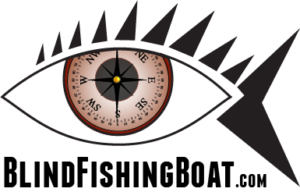
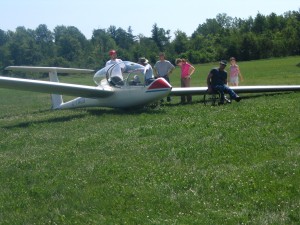
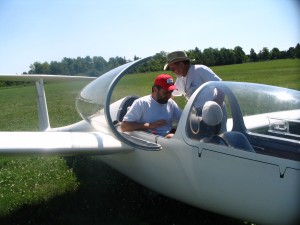
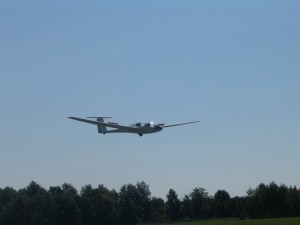
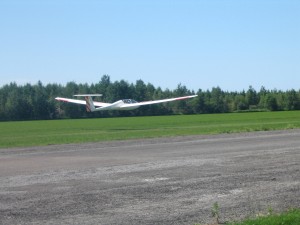
Comments are closed.